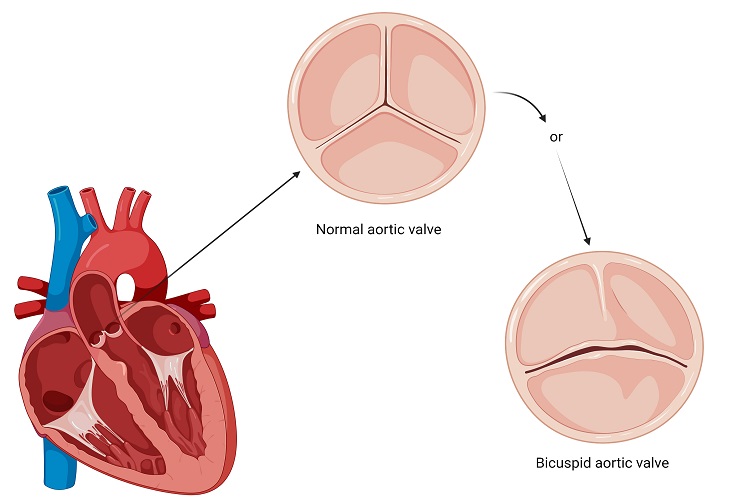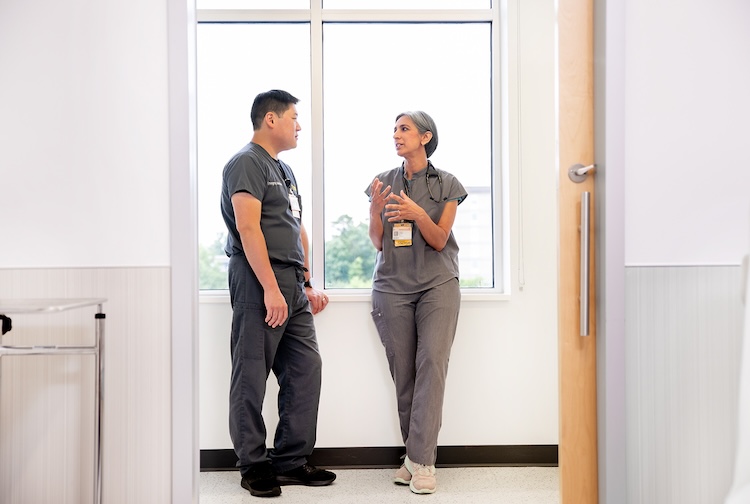Learn more about bicuspid aortic valve, the most common congenital heart defect
October 24, 2022 A bicuspid aortic valve can eventually narrow, stiffen or even leak.
A bicuspid aortic valve can eventually narrow, stiffen or even leak.
What is a bicuspid aortic valve?
An aortic valve is a like a door that sits between your heart chamber and your aorta (a major blood vessel that supplies your entire body). The function of your aortic valve is to open, allowing blood to leave your heart to supply your body, then close to prevent blood from leaking back into your heart. A normal aortic valve has 3 leaflets in order to function properly. A bicuspid aortic valve (BAV) is an abnormal aortic valve that only has two leaflets instead of the normal three. This is a congenital condition which means people are born with it and cannot acquire this condition later in life.
How common is it? Why?
Approximately 1-2% of the population are born with BAV, making it the most common congenital heart condition.
While there is no known cause and specific genetic mutations have not been identified, it is possible to inherit a bicuspid aortic valve. In fact, up to 10% of first-degree relatives of people with bicuspid aortic valve can have this condition. People with certain congenital heart conditions or certain syndromes (such as Turner syndrome or coarctation) also have a higher likelihood of having a bicuspid aortic valve.
What are some symptoms of bicuspid aortic valve?
Most people with bicuspid aortic valve have no signs or symptoms of valve dysfunction until later in life. However, severe symptoms can occur in infants or children if there is significant abnormal valve function such as valve stenosis (narrowing/stiffening) or regurgitation (leakage). The symptoms of a bicuspid aortic valve include chest pain, shortness of breath, dizziness, passing out, and difficulty exercising.
Bicuspid aortic valve-associated aortopathy is a common condition. Aortopathy is abnormal genetic composition of the major blood vessel (aorta) that helps get blood from the heart to the rest of the body. The aorta can become dilated over time which increases the risk of aortic dissection and rupture.
People with bicuspid aortic valve are more likely to develop endocarditis, an infection of the heart valves and heart linings. Therefore, it is important for people with BAV to maintain good hygiene and take good care of your skin, teeth, and oral cavity.
If I have a bicuspid Aortic valve what do I need be followed for?
Functioning of your aortic valve will need to be monitored for progression of valve stenosis (tightness) and/or valve leakage. Your heart chamber size, wall thickness, and pumping function will also need to be monitored, as well as any progressive enlargement of your aorta, which frequently occurs in people with BAV.
How does it affect pregnancy?
Most pregnant women with BAV without significant stenosis or leakage tolerate pregnancy well and may not develop any complications related to the heart during pregnancy.
However, because massive hormonal and hemodynamic changes occur during pregnancy, some people can develop symptoms related to abnormal bicuspid aortic valve function during this time, especially if there is underlying valve narrowing or leakage. Progressive dilation of the aorta may also occur during pregnancy as a result of these hormonal and hemodynamic changes.
Cardiac complications may include heart failure, arrhythmias, and aortic dissection, which may lead to poor maternal and fetal outcomes.
Because a bicuspid aortic valve and/or other congenital heart disease can be passed down to your baby, a fetal echocardiogram should be used to check the baby's heart as a part of labor and delivery planning.
It is recommended to discuss with your cardiologist, particularly an adult congenital heart disease specialist, prior to pregnancy to determine whether it is safe for you to become pregnant, and to establish a plan of care throughout pregnancy to ensure good outcome for you and your baby.
What testing is important and why?
If there is a suspicion you may have a bicuspid aortic valve, an echocardiogram (an ultrasound of the heart) is needed to confirm a diagnosis, and to assess for any stenosis or leakage of the aortic valve. If a dilated aorta is suspected or identified on the echocardiogram, then more advanced imaging studies, such as a dedicated computed tomography angiography (CTA) or magnetic resonance angiography (MRA), may be recommended to further evaluate the anatomy and dimensions of your entire aorta.
Who and how should we screen for BAV in the family members of BAV patients?
Because BAV can be passed down in families, it is recommended that parents, children, and siblings (first-degree relatives) of people with bicuspid aortic valve be screened with an echocardiogram at least once in life. Up to 30% of first-degree relatives of people with BAV can have progressive enlargement of the aorta, even if they do not have bicuspid aortic valve, and may need to be screened more than once. If you have a family history of BAV, please talk to your doctor to determine your need and frequency of screening.
What are some treatment option?
Children and adults with bicuspid aortic valve need regular checkups and serial echocardiograms to monitor the function of the valve and aorta size.
Treatment depends on the extent of valve dysfunction and the degree of dilated aorta. There are no medications to treat or slow progression of a bicuspid aortic valve. However, certain medications to treat related heart problems such as high blood pressure may be prescribed. If there is severe valve stenosis or leakage, a valve intervention, such as surgical or percutaneous aortic valve replacements, can be offered to restore normal aortic valve function. Surgery may also be needed to correct the enlarged aorta.
How long can I live with a bicuspid aortic valve?
A bicuspid aortic valve typically functions well throughout childhood and early adulthood, and most people born with a bicuspid aortic valve can live a healthy normal life with a normal life expectancy with proper treatment and follow up.
Who can I see with a bicuspid aortic valve?
If you have a bicuspid aortic valve, you will likely be referred to a heart doctor who specializes in congenital heart disease (congenital cardiologist) who can follow you long-term in an Adult Congenital Heart Disease (ACHD) Program.




